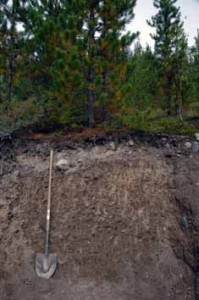Soil Site Details: Kamloops Luvisol
Soils on this site are Luvisols. Over long periods of time, fine clay particles have slowly washed from the surface and accumulated deeper into these soils. The name Luvisol originated from the Latin word luo meaning to wash.
Basic Facts
Soil Order: Luvisol
Ecosystem: Coniferous Forest
Climate Zone: Semi-arid
BC Biogeoclimatic Zone: Interior Douglas Fir
Location: 5km south-west of Kamloops
City, Region, Country: Kamloops, British Columbia, Canada
Lat / Long: 50.6586/ -120.637
Soil Order: Luvisol
Great Group: Grey Luvisol
Subgroup: Orthic Grey Luvisol
Soil Series: Tunkwa
Classification Code: O.GL
Soil Horizons Present: Ah, Ae, Bt, Cca
Diagnostic Horizon 1: Bt
Diagnostic Horizon 2:
Diagnostic Horizon 3:
Diagnostic Horizon 4:
Land Form: Glacial till (blanket)
Parent Material: Glacial Till
Elevation (m): 915
Topography: Inclined
Affected by Glaciation: Yes
Climate Zone: Semi-arid
Mean Annual Temperature (C): 9
Minimum Annual Temperature (C): 3.3
Maximum Annual Temperature (C): 14.4
Mean Annual Precipitation (mm): 400
Current Land Use: 2nd growth forest
Original Vegetation: Douglas-fir, pinegrass, lodgepole pine, ponderosa pine
Current Vegetation: Douglas-fir, pinegrass, lodgepole pine, ponderosa pine
Soil texture horizons: Silt loam (Ae), Clay loam (Bt)
Soil structure horizons: Weak granular (Ae), Platy (Bt)
Forest Humus Form:
Presence of Charcoal:
Presence of Coatings:
Primary Soil Process: Clay redistribution
Secondary Soil Process:
Links
Resources home: Principles, Land use, awareness, etc.
Processes: Luvisol
Classification: Luvisol
Virtual soil monoliths: via the left-side expanding menu.
Media

Luvisol, from https://processes.soilweb.ca/luvisol/.
Featured Expert: Dr. Paul Sanborn
Video host: Dr. Art Bomke